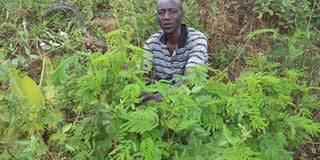Feed options for dairy animals in the wake of dwindling fodder

Moses Alukutsa in his farm in Vihiga where he grows calliandra, an alternate and nutritious animal feed. The concept behind a dairy cow is to eat quality grass at all times to produce milk and to remain healthy. FILE PHOTO | NATION MEDIA GROUP
What you need to know:
- The concept behind a dairy cow is to eat quality grass at all times to produce milk and to remain healthy, therefore, quality should be maintained.
- In milk production, for instance, the stovers only offer about 2 per cent crude protein but a lactating cow needs about 16 per cent CP to produce more milk.
- There is hype that stovers mixed with molasses gives more milk. Molasses only gives little energy and is just a sweetener for palatability.
- Crop residues like pods, legume stovers from sweet potato and groundnuts can also be used. In some areas, napier grass is available, harvesting and feeding at the right stage will help.
Good quality fodder is becoming hard to come by as the dry spell bites and prices increase. Save for those who preserved feeds like hay and silage, the rest of the farmers are having it rough.
It is more hurting that the weatherman foresees rains only from April, three months away.
Most dairy farmers are now turning to maize stovers, and wheat and rice straws, with others grinding maize cobs.
While farmers want to sustain milk production, the feeds are doing your cow more harm than good.
The concept behind a dairy cow is to eat quality grass at all times to produce milk and to remain healthy, therefore, quality should be maintained.
Maize stovers, wheat straws and the cobs are very poor in quality and should not be relied on as the primary source of feeds.
The main role they play is to help your cow maintain daily functions – urinating, standing and walking, with more cow dung in return.
But major processes like milk production, heat detection, growth rate and reproduction are greatly interfered with.
In milk production, for instance, the stovers only offer about 2 per cent crude protein but a lactating cow needs about 16 per cent CP to produce more milk.
Understanding the whole concept of quality fodder for animals is key.
RICH IN CRUDE PROTEIN
At flowering stage, plants prepare to make fruits or seeds, mobilising nutrients from other parts. This is why fodder is normally harvested at a younger stage (not too lush) when the whole plant is still rich in crude protein.
But straws are what remains after rich wheat has been harvested, the same case with maize cobs, all which should be used as fillers but not primary feeds.
In most cases, they are used when animals have fed on lush pastures to aid in digestion.
There is hype that stovers mixed with molasses gives more milk. Molasses only gives little energy and is just a sweetener for palatability.
During the dry spell, the cow’s ability to consume more dry roughage is limited mainly due to unpalatablity. The way to get the best out of stover or straws is by quality modification through treatment with urea for instance.
In this case, chop maize stovers into small sizes with no sharp ends before treating.
That is a little urea is added to increase palatability. If you are new to this, expert guidance is recommended as urea can be toxic if not well utilised.
Other feeds to explore include dairy meal and multi-purpose tree varieties like leucaena that thrive with low water supply.
INTERGRATE FEEDS
Crop residues like pods, legume stovers from sweet potato and groundnuts can also be used. In some areas, napier grass is available, harvesting and feeding at the right stage will help.
With resources, some farms also prefer buying feed materials to go Total Mixed Ration or even hydroponics. The whole idea is to integrate feeds from both energy and protein sources.
Where grass is still available, rotational grazing is recommended alongside supplementation.
But note, a cow has all the tools (four stomachs) to utilise high quality rations, if you can trust her by spending a little more now, she pays back by guaranteeing you more milk while in good health.
Remember, at this time that feeds cost higher milk prices will also rise, thus the animal will sustain herself.
The writer is based at the Animal Sciences Department, Egerton University.





